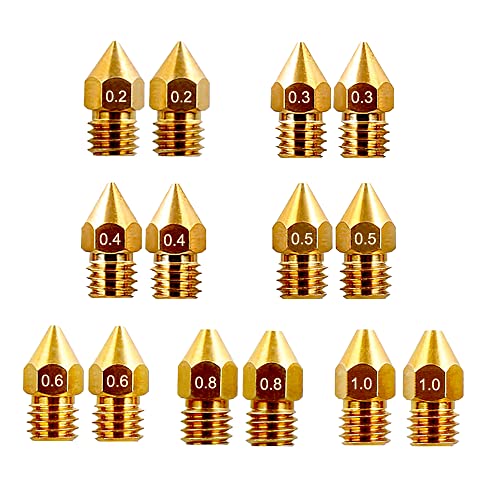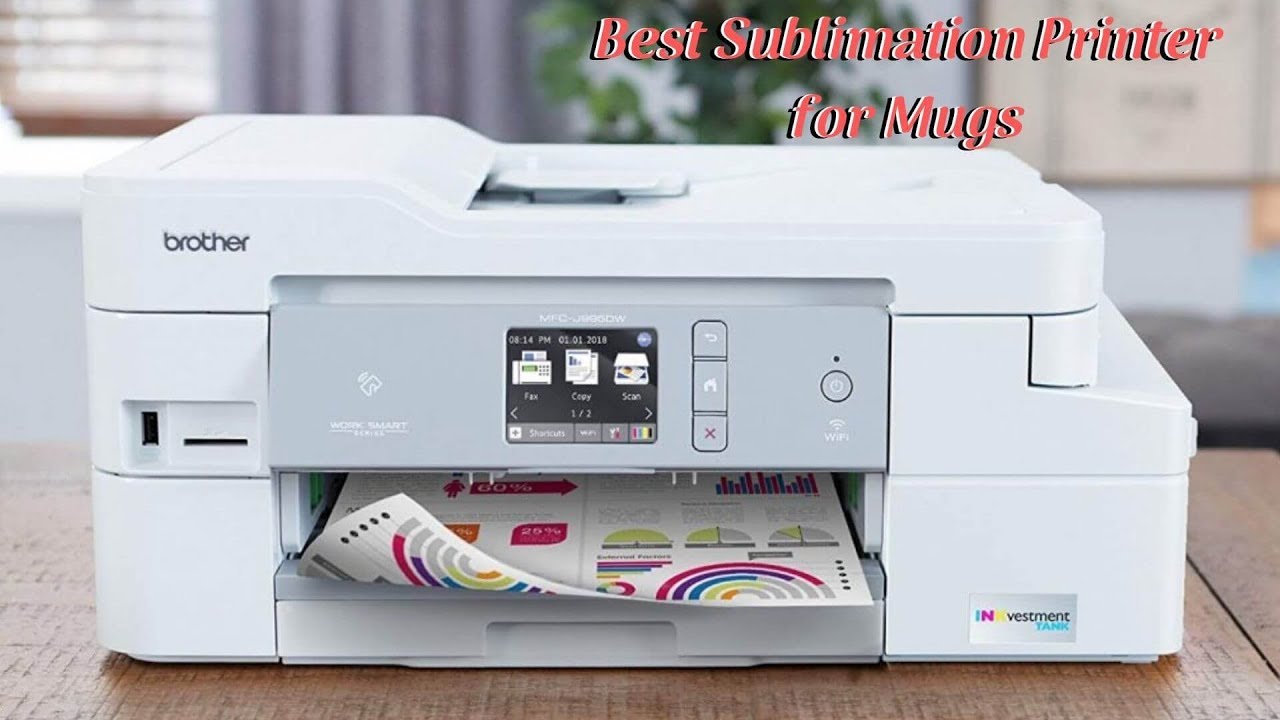Best 3d Printer Nozzle Material For 2024
Gretchen Rubin Apr 26, 2024 9:33 AM
Choosing the best 3d printer nozzle material is a key step to making a great print. The best material will depend on your printer type and what you want to achieve. In general, hardened steel is the best material, while brass and hybrid materials are a good choice for those who are trying to create a print that is sturdier.

Compare Products
- SCORE9.6
- Branduxcell
Last update on 2024-04-26 / Affiliate links / Images, Product Titles, and Product Highlights from Amazon Product Advertising API
Hardened steel
Whether you're printing traditional filament materials, advanced 3D materials, or a range of other filament types, the best 3d printer nozzle material is hardened steel. Using hardened steel will help you keep your prints consistent, and ensure that they're free from clogging or other issues.
Hardened steel is an extremely durable material, and with proper care and maintenance, a hardened steel nozzle can last years. Some people even print exclusively with hardened steel nozzles. However, this is a high-priced option, and you'll be looking at spending around $10 to $15 per nozzle. It's important to find a reliable supplier to ensure that your nozzle doesn't have any extrusion problems.
You can also try out a hybrid nozzle such as the Micro Swiss Plated Brass Nozzle. This nozzle has a minimal friction nozzle, which helps reduce wear and prolongs nozzle life. It also has a hard surface, which provides abrasion resistance.
The E3D Hardened Steel Nozzle is a great option for 3D printing with abrasive filaments. It's available in a range of sizes, including 0.4 mm and 0.3 mm, and is suitable for a variety of materials. It's also compatible with a wide range of 3D printers, including the popular V6 hot end.
The E3D Hardened Steel nozzle is also a good option for printing with thermoplastic filament. It features a hardened tool-steel base and nickel plating, making it a versatile nozzle. Its high-temperature resistance makes it suitable for a range of materials, including copper.
A hardened steel nozzle is also recommended for printing exotic filaments such as glow-in-the-dark filaments. They're also good for standard filament materials, such as PC and nylon. This is because hardened steel nozzles are designed for abrasion. They can also handle strong filament materials such as acrylic.
No matter which 3D printer nozzle you choose, you'll need to invest some time and effort into finding the right one for your needs. It's also important to keep in mind that nozzles made from different materials will perform differently. A cheap clone of a Hardened Steel nozzle is more likely to have a rough interior finish, which can interfere with the smooth extrusion of your filament.
Brass
Choosing the right 3d printer nozzle material is essential for successful 3D printing. Nozzles are made from several different materials, and choosing the wrong material can ruin your print. Here are some tips to help you choose the right material for your printing needs.
There are three main types of 3d printer nozzle material: brass, stainless steel and hardened steel. Brass is an inexpensive material that is suitable for most filaments. Brass is also a soft metal, so it is more prone to wear when used with abrasive filaments. However, abrasive filaments do have some advantages.
Brass nozzles are great for printing common materials such as ABS, PLA, and flexible filaments. Brass nozzles are also easy to produce and are a good choice for printing materials without additives. However, they are not ideal for printing materials with additives because they can wear out faster.
Hardened steel nozzles are stronger than standard brass nozzles and are great for printing abrasive materials. They are also more durable, so they will last longer. However, hardened steel nozzles may require higher temperatures to print abrasive materials. Moreover, they are not as thermally efficient as brass. This can result in slower printing speed.
Hardened steel nozzles are ideal for printing metals. However, they have low thermal conductivity and can result in unstable filament extrusion speed. This can be an issue when using nozzles with large diameters.
If you are using abrasive filaments, the best option is to use a nozzle that has a high thermal conductivity. This will result in smoother extrusion and less pulling. The nozzle should also have a diameter greater than 0.4mm. This allows for more material to be deposited, which will speed up the printing process.
If you are not sure which nozzle material to use, the best choice is to use a nozzle with a ruby tip. Ruby-tipped nozzles have an exceptional abrasion resistance and retain the thermal conductivity of brass.
Other nozzle materials include tungsten carbide, a composite with additives, and ColorFabb SteelFill and Bronzefill, which are made from a blend of stainless steel and bronze. However, tungsten carbide nozzles are still more expensive than brass nozzles.
Hybrid
Choosing the correct 3d printer nozzle material is a crucial factor in producing a high quality and functional 3D print. While there are many different materials to choose from, it is important to select one that will fit your 3D printer and your needs.
When determining the best nozzle material for your 3D printer, consider the size of the part you are printing and your mechanical requirements. If you are printing a large functional item, you will likely need a larger nozzle to get the job done. If you are printing a small, detail-oriented model, you may want to use a smaller nozzle.
Larger nozzles can extrude thicker layers, which means more material is deposited in each layer. Larger nozzles also have more freedom when it comes to flow rates. They have less trouble extruding filament and therefore are more efficient. They are also less likely to clog.
Small nozzles can be useful for printing miniatures, but they are not ideal for printing abrasive filaments. Abrasive filaments are filled with large particles. These particles can get clogged up in a small nozzle, causing a poor print.
The size of the nozzle orifice can also affect the accuracy of your print. The diameter of the nozzle is important for determining the precision of your 3D print. A nozzle with a smaller diameter will require more passes to fill a larger area.
The most common nozzle material for 3D printers is brass. This metal is a soft metal that is readily available and inexpensive. Brass is ideal for use with PLA or ABS filaments.
Stainless steel is another popular material for 3D printer nozzles. Although it is more durable, it has poor thermal conductivity. Stainless steel is not recommended for use with abrasive filaments.
Hybrid nozzles combine the advantages of both materials. A brass nozzle with a ruby tip can offer good thermal performance and longevity. Brass is also inexpensive, so you will likely be able to re-use the nozzle more often than you would with a Stainless Steel Nozzle.
If you are planning to use a hybrid 3d printer nozzle, you should make sure it has the following qualities: longevity, durability, and heat conductivity. You should also consider the price.
E3D V6
Choosing the right 3D printer nozzle material is important for ensuring the quality of your prints. You need to choose a nozzle that is suitable for your filament type, and it will affect the time it takes to print your creations. It is best to spend a little time finding the right nozzle for your printer. There are several different nozzle materials, and each is suitable for a different type of printing.
The most common material for 3D printer nozzles is brass. Brass is a great choice for standard, non-abrasive applications, and it also provides good heat transfer. However, it does not have the same abrasion resistance as harder metals. Brass nozzles can be coated with nickel or chrome, which helps to reduce friction between the filament and the nozzle. This allows the nozzle to be more economical.
Hardened steel is a good choice for abrasive filaments. Although it is not as cheap as brass nozzles, it is more durable and will last for a long time. Hardened steel nozzles are also a great choice for 3D printers that use metal-filled filaments. They are not suited to printing abrasive filaments above 350degC.
If you want a nozzle that is compatible with many 3D printers, the E3D Hardened Steel Nozzle is a great option. It has a nozzle size of 0.4 mm, which is standard for most printers. This allows for a good balance of precision and resolution. It is also compatible with a variety of different filament types.
The E3D Hardened Steel Nozzle is also available in a few different diameters. It is a great option for 3D printers with a V6 hot end assembly. It is also compatible with Prusa i3 and i3 MK2 3D printers. It also comes with a lifetime wear warranty.
The E3D V6 hot end is one of the best hot ends for 3D printers, and it can be used with a wide variety of different filaments. It is also a great option for users who want a direct extruder. The hot end comes as a kit, and it can be converted into a direct extruder.


























